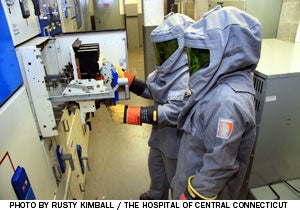Partner helps put electrical standard in hospital's reach
 An ounce of prevention is worth a pound of cure, so the saying goes. In the case of high-voltage electrical systems, preventive action to comply with safety standards can deter serious injury and even death to workers as well as avoid fines and lawsuits.
An ounce of prevention is worth a pound of cure, so the saying goes. In the case of high-voltage electrical systems, preventive action to comply with safety standards can deter serious injury and even death to workers as well as avoid fines and lawsuits.
Recognizing the seriousness of the issue, Robert W. Hall, director of engineering, The Hospital of Central Connecticut, New Britain and Southington, Conn., recently took steps to make sure that facilities at the two campuses were in full compliance with National Fire Protection Association (NFPA) 70E: Standard for Electrical Safety in the Workplace.
The Occupational Safety and Health Administration expects employers and employees to comply with the provisions of NFPA 70E. In general, compliance involves putting an electrical safety program in place that will identify and analyze electrical hazards in the workplace, educate the workforce on those hazards, require the use of appropriate personal protective equipment (PPE), and implement warning labels and guards to protect workers.
"We wanted to make sure we didn't have any problems with the electrical system," says Hall. "That's why we hired a third-party consultant to come out and look at it from top to bottom and make sure we were fully compliant."
Hall worked with supplier Grainger Inc., Lake Forest, Ill., and engineers from Schneider Electric, Palatine, Ill., to investigate the hospital's electrical system for full compliance with NFPA 70E. In addition to conducting a full electrical risk assessment, engineers also conducted an arc flash analysis, says Hall.
Studies report that there are an average of five to 10 arc flash incidents every day in the United States, resulting in serious injuries. An arc flash can be fatal, although the number of incidents is unclear. The temperature of an arc flash, which is caused by an electrical system short circuit, can reach up to 35,000-degrees Fahrenheit or three times hotter than the sun. An arc flash can vaporize metal and send a blast of plasma and molten metal in all directions.
Schneider performed an arc flash analysis that identified all electrical panels and components where arc flash hazard warning labels were required. Engineers also identified the specific type of PPE required to work in a hazardous area, says Hall.
"We were always somewhat in compliance with NFPA 70E, but not to the extent we wanted to be," says Hall. "We needed some additional help and it was always in the back of my mind to work on that."
Hall now has some additional peace of mind knowing his workers are safer.




